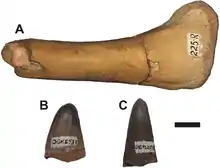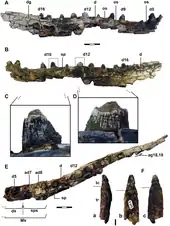Roxochampsa
Roxochampsa is an extinct genus of crocodylomorph from the Late Cretaceous of Brazil belonging to the sebecosuchian clade Itasuchidae.[1] The type species is R. paulistanus.
| Roxochampsa | |
|---|---|
 | |
| Original material, including lectotype teeth and assigned tibia | |
| Scientific classification | |
| Kingdom: | Animalia |
| Phylum: | Chordata |
| Class: | Reptilia |
| Clade: | †Sebecosuchia |
| Clade: | †Sebecia |
| Family: | †Itasuchidae |
| Genus: | †Roxochampsa Piacentini Pinheiro et al., 2018 |
| Species: | †R. paulistanus |
| Binomial name | |
| †Roxochampsa paulistanus Roxo, 1936 | |
| Synonyms | |
| |
Discovery and naming

Roxochampsa was originally described as a new species of Goniopholis, G. paulistanus, in 1936, based on two teeth (DGM 259-R and DGM 258-R) and a tibia (DGM 225-R), all from the Adamantina Formation of São Paulo state, Brazil.[2] However, Andrade et al. (2011) rejected referral of the species of Goniopholis and treated it as a nomen dubium referable to Neosuchia indeterminate.[3] Pinheiro et al. (2018) described new jaw material from the Presidente Prudente Formation of the Alfredo Marcondes municipality in São Paulo state, and noted that the tooth crowns in the jaw material morphologically matched the teeth in the syntype series of G. paulistanus. They erected Roxochampsa for the species, designating DGM 259-R and DGM 258-R as the lectotype and paralectotype respectively, while assigning the tibia (collected at a different locality than the teeth) to Sebecosuchia indeterminate.
References
- Piacentini Pinheiro AE, Pereira PVLGdC, de Souza RG, Brum AS, Lopes RT, Machado AS, et al. (2018) Reassessment of the enigmatic crocodyliform "Goniopholis" paulistanus Roxo, 1936: Historical approach, systematic, and description by new materials. PLoS ONE 13(8): e0199984
- Roxo MGO. On a new species of fossil Crocodilia from Brazil, Goniopholis paulistanus sp. n. An. Acad. Bras. Ciênc.. 1936; 8: 33–36
- Andrade MB, Edmonds R, Benton MJ, Schouten R. A new Berriasian species of Goniopholis (Mesoeucrocodylia, Neosuchia) from England, and a review of the genus. Zool J Linn Soc. 2011; 163: 66–108.
